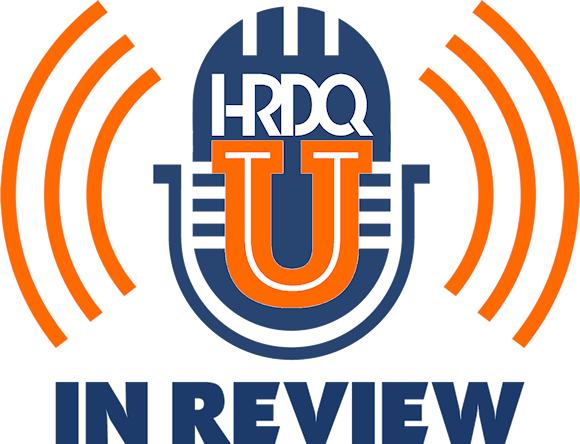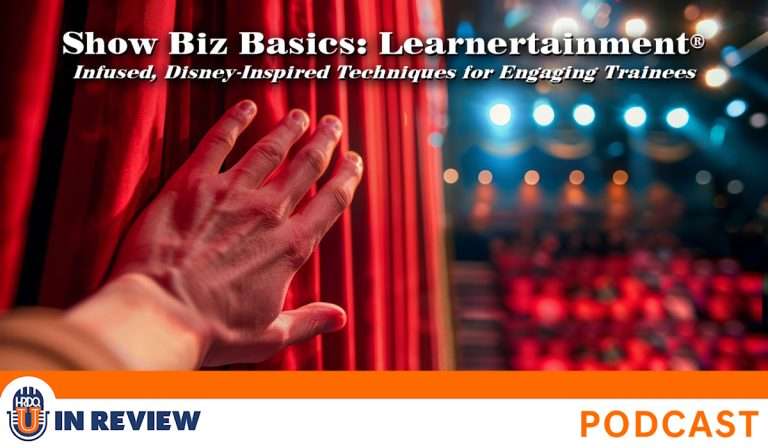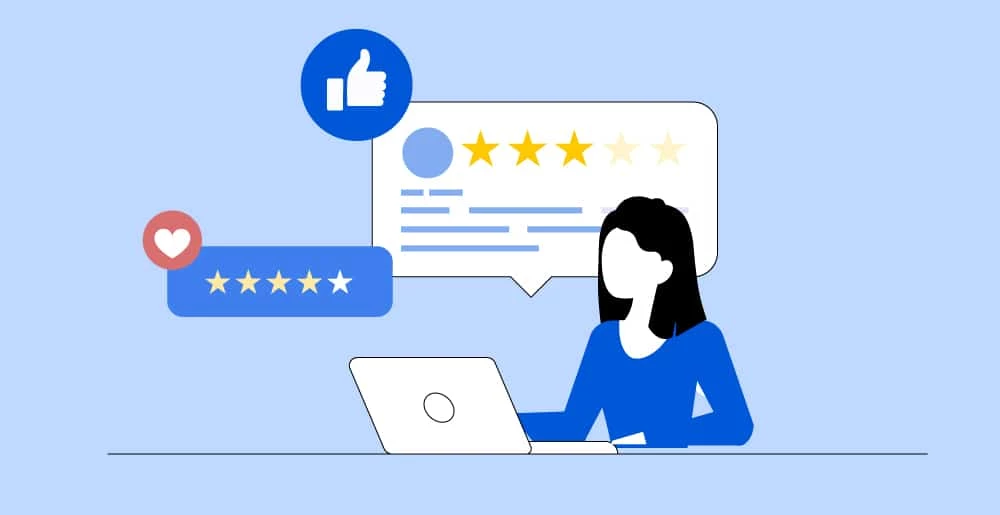

Host Sarah sits down with Lenn Millbower to explore the power of learnertainment and Disney-inspired training techniques. With 25 years at Walt Disney World and a background in entertainment, Lenn shares how engaging the limbic system can make corporate training more memorable and effective.
From sound oversight to creating harmonious learning environments, Lenn reveals practical tips trainers can use – no comedy skills required! Discover how props, music, and sensory details can transform corporate training without overshadowing learning objectives.
Key Takeaways:
Chapters:
⏱️ 00:01 – Introduction and Background
Sarah introduces the HRDQ-U In Review Podcast and welcomed Lenn Millbower to discuss Showbiz Basics and Disney-Inspired Training Techniques. Lenn shares his journey from childhood entertainer to Disney trainer.
⏱️ 02:45 – The Connection Between Entertainment and Learning
Lenn explains how his experience as a band performer influenced his training approach, highlighting how he learned to manipulate crowd energy through music selection.
⏱️ 04:12 – Common Training Mistakes and Solutions
Lenn addresses the issue of “icebreaker phobia” and explains how activities should flow naturally within corporate training sessions instead of feeling forced.
⏱️ 05:44 – The Power of Learnertainment
Lenn discusses the importance of the limbic system in learning and shares how even firefighters engaged positively with creative activities when presented correctly.
⏱️ 13:00 – Disney-Inspired Training Techniques
Lenn details Disney’s approach to creating harmonious environments and how these principles can be applied to training spaces, from sensory elements to room setup.
⏱️ 17:59 – Practical Implementation Tips
Lenn shares practical strategies to make training more engaging, including how to use props effectively and balance entertainment with learning objectives.
Tune in for practical leadership insights and strategies to stay flexible and effective in today’s evolving workplace!
Resources and Links:
Watch the webinar: Show Biz Basics: Learnertainment Infused, Disney-Inspired Techniques for Engaging Trainees
More from Lenn: Bundle Discounts on Lenn’s Most Popular Books and Resources
00:01
Welcome to this week’s episode of the HRDQ-U In-Review Podcast, where we bring you the latest insights and practical tools for enhancing soft skills training in your organization. This podcast is brought to you by HRDQU.com, and I’m your host, Sarah, Learning Events Manager at HRDQ-U. Today, we’re joined by Lenn Millbower to discuss the webinar, Show Biz Basics: Learnertainment Infused, Disney-Inspired Techniques for Engaging Trainees. Before we dive in here,
00:28
Be sure to subscribe to our newsletter at HRDQ.com for exclusive updates, upcoming webinars and resources to help you and your team excel. Lenn, let’s get started. Thank you so much for joining me today. Great. Glad to be here. So Lenn, for our new listeners that haven’t got to hear from you before, can you share a little bit about your background and how you got to where you’re at today? I’m getting kind of old, so it’s a very long background. Let me see if I can do it very quickly.
00:58
As was a magician, a puppeteer, and as I grew into adulthood, I went away to music college, Berklee College of Music, and I spent 10 years on the road as an entertainer, a magic music act. From there, I went to Walt Disney World. spent 25 years. And the reason this entertainment stuff from childhood is important is that Walt Disney World, they figured out that I really needed to be a trainer.
01:24
that I had those skills and I hadn’t realized it, but I’d been teaching people stuff all my life. I taught my brother and sister how to run the puppets so that we could do puppet shows. And when I was on the road as a musician, I was teaching all the vocal parts to the band members. And as I got into the training field, I started to notice that it could be somewhat boring, that people tended to fall asleep on training a lot and that
01:53
that a lot of trainers and instructional designers basically put a bunch of bullet points in order and called that a training session. And I looked back at my entertainment background and I thought, hmm, there’s more to this than that. And so I started applying entertainment techniques to training. Eventually I realized that that’s where Walt Disney was coming from too, although he wasn’t in the training field. But my first book was Training with a Beat, How to Use Music.
02:22
And quickly expanded from that into another book called showbiz training. And the idea was to take all those things I’d learned as a professional entertainer and infuse them into training so that you could keep your trainings awake so the learning can take. And that’s what a lot of my life has been dedicated to since that time. So ultimately that’s what inspired you to explore the connection between entertainment and learning.
02:51
Yes, there really are connected and I suppose, well, let me go one step deeper. When we were a band, we performed in 48 of the 50 states and we did a year on the cruise ship. I was often the guy who would look at the crowd and decide what the next song would be. We didn’t use defined set lists because I found that you could manipulate the crowd for their benefit by
03:21
just by selecting the right song. And so it seemed natural to me that in training, you could manipulate the trainees for their benefit just by selecting the right entertainment technique. That’s really impressive. I didn’t know that part of your story. Yeah, that was really the genesis of it. And most bands, when they start a new song, the drummer will go one, two, one, two, three, four. Well, I had the group trained to start with a two beat
03:51
count off so we could end the song like one, two, click, click, and we’re into a new song. So we could keep the energy going all night. Oh, that’s really fun. so, you know, trainers, they’re always looking for ways to make learning more engaging. What’s one common mistake that they make when they’re trying to do this? Common, did you say mistake? Yes. The biggest mistake I see is…
04:20
icebreaker phobia, I would call it. Of course, the most rookie mistake of them all is, okay, now we’re going to do an icebreaker, which is just not the way to announce something. But the idea that it’s been a long enough amount of time, so we have to plug an activity in here. And I would suggest that if people notice that there’s an activity starting, then it’s not very good because your instruction should just flow.
04:50
and the activity should just be, of course there’s an activity here, because it’s part of the flow. It’s not a case of, okay, I want everybody to stand up and find somebody else who has a cat and two dogs. That is the worst, worst of all possible worlds. To talk metaphorically, they call them icebreakers, but really shouldn’t we be melting the ice, not breaking it?
05:16
And the way you melt the ice is to have activity that flows from the natural progression of the instruction and illuminates what’s going on, not just something plugged in because it’s been 20 minutes and they’re falling asleep. And Len, you emphasize the power of learner attainment in training. What exactly is learner attainment and why is it so effective? Well,
05:45
It is, it’s entertainment for learners. And the main reason it’s so effective is something called the limbic system, which is in our brains. Let’s face it, everybody likes to be entertained. That’s why TV is so big. That’s why there’s a Netflix. That’s why there’s movies, there’s books.
06:10
podcasts now like what we’re doing and people like to be entertained. I actually, I spent 25 years at Walt Disney World and I remember the orientation program I’m put together for Epcot Entertainment. The third step in the orientation was for the participants to draw their mission and life. And I had this leader, well-intentioned, suggest to me that, well, my firefighters who,
06:40
where the guys loading the fireworks for the Epcot show. My firefighters will not like that activity. When I asked why not, they said, well, firefighters don’t draw. Just flat out, they don’t do that. And I said, well, do they go to the movies? She says, oh yeah. I said, okay, so they like to be entertained.
07:04
So this will work. And when we did the activity in the class, they were actually the most engaged participants. And I discovered to my surprise that the reason they’re firefighters was not that they were big, tough macho men, they were firefighters because they were softies who liked saving people. So they were the best drawers of them all. I just found that because people like to be engaged.
07:33
They like to be entertained. And when something as memorable as happening, the learner system, the limbic system, which is in the center of our brains, it is like a trigger for the limbic system. And the trigger can be negative or it can be positive. And facing a lot of training classes sometimes can be very negative. You’re there.
07:59
having to admit you don’t know something, you’re being forced to be there, you should be the instructor, not the person doing that. You don’t like the people in the room. I mean, there’s all sorts of issues going on that the trainer doesn’t always know. And so the limbic system in your brain is already on guard. By the way, the limbic system is the area where the flight or fight response comes from. So if you can engage the limbic system,
08:27
people relax and they enjoy themselves, they have a good time. And this next point is a critical point. The limbic system is also the gatekeeper to long-term memory. Now, a lot of very bad things like what happened at 9-11 are remembered by our brains. But the moral or lesson I take from all this is if your trainees are having a good time in your classroom, that memory of that experience may stick with them.
08:57
in a way that just regurgitating facts doesn’t. In fact, I’ll often tell people in my classes that logic proves, but emotion moves.
09:10
And so in this recent webinar that you presented here, showbiz basics, learner team, and infused Disney inspired techniques for engaging trainees. First off, if you haven’t watched the webinar yet, make sure that you do so. We’ll have that linked below so that you can check that out. I highly recommend you check it out. It was a really fun session. But Len, could you share what the key takeaways were for our registrants at this event? Well, it covered eight techniques that
09:40
that I call learner attainment. We actually kind of already talked about the first one is emotion creates memory. So we’ve talked about that. Another one of them is SoundTrump site. And the point there is music and it’s using music in a classroom. And it’s interesting. I can prove that SoundTrump site because when films first came out,
10:09
the silent films, they felt so ghostly, so eerie that people couldn’t quite adjust to it. They actually had to put piano players and organists in theaters to cover, to give it some sound. In fact, if you want to prove to yourself that sound is important, put on a video in a classroom and turn off the sound and see what happens. And I guarantee you within 30 seconds, people will start talking.
10:39
because they just can’t stay on the quiet. So why not use that inclination towards music to help attract people? there, as a for instance, there are two kinds of music I use. I use happy uptempo music, kind of popular stuff. I try not to use anything that’s too, too current because it just brings you into current world.
11:07
rather, I’d rather pick something that’s 10, 15 years old. And the other kind of music is reflective music. And that’s, that’s like softer, no lyrics, minor key, which makes it kind of sad. And you use that when people are discussing things or thinking to themselves. And a big thing I do is I have playlists. So I have a playlist for doctors and hospitals and that sort of thing. Those, those
11:37
kind of professionals and songs on it. One of them I love, seem to use this song a lot, is You Can’t Touch This, the old rap song, because it’s kind of funny, you you can’t touch this because it hurts so much. Another song is I Don’t Need No Doctor, another song is Which Doctor. The idea is to do songs that are related to the session as people are coming in, happy up-tempo songs with lyrics, and that just establishes
12:06
a mood that keeps people happy. So when I did this showbiz basics for the Trainy Magazine conference, I took the song Good Times by Sheik and I found the long play version of it. And I started in the middle of that, which is just the bass part. And for five minutes, the song built and built and built to got into the chorus. These are the good times. And then
12:35
At that point, I started the presentation because what I was doing subconsciously was telling people they’re going to have a good time and this was a good time being in this room. So that’s one example of how to use music. Wow. And so Disney is known for creating magical experiences. Can you share an example of how a Disney inspired approach has transformed a training session? Sure. Walt said,
13:04
There are many examples. the music is a good example because every location has its own style of music that fits the surroundings. But the key point about Walt Disney World and Disneyland is that nothing in the parks is out of place. Or it used to be that case. The kind of the management right now is kind of weird in some of the placement of things. But, you know, when you go to a mall,
13:32
you get fatigued fairly quickly. And the reason for that is because you’ve got all these different sensory things bombarding you. Sight sounds, lots of noise going on. And Walt created his theme parks so that everything was harmonious. So we’ve been talking about music. So the music’s right, the colors are right, the feel is right, the smells are right. So as a for instance, when you walk into the Magic Kingdom,
14:02
The first thing you pass is the popcorn wagon. That’s not an accident because you are stepping into the movie. The movie is 3D and you’re part of the movie now and you’re on Main Street USA and you’re smelling popcorn. You walk halfway down the street and the cookie smell comes at you. Not an accident again. So you’ve got color working. You’ve got the music. You’ve got the…
14:29
all the sights, the smells, the actors on the street are all dressed in appropriate themed era costumes. mean, everything about that experience and that place and time is harmonious. So that directly applies to a training room because I think we don’t spend enough time thinking about the elements in the training room. So for instance, when people are walking
14:58
down the hallway towards this room. How’s the floor feel? When they grab the handle on the door, how’s that handle feel? Is it dirty? Is the door dirty? Does it squeak when it opens? That’s kind of like a haunted mansion for boating. When you walk into the room, what do you see? How’s the temperature? What sounds are playing? How’s the instructor look?
15:26
Harry trying to get things set up or welcoming the materials? Do the materials you’re going to be working with feel sturdy or are they flimsy pieces of paper? The seat, can you see the room from the seat? When you look at the walls, do the walls communicate what’s going on in the session? So for instance, when I was designing custodial, I actually used three different custodial classes for the mouse.
15:56
AM, PM, and third shift. So for the AM and PM classes, we’d have the custodial equipment around the room. I mean, that’s a perfect thing. Now people are going to look away from you at some point. So what are they looking at? Are they looking at a pile of chairs or a stack of stuff from another class? Or are they looking at things that will remind them of the content? Because they’re going to look away.
16:25
And what are they seeing in you? And that’s another one of the principles is your professionalism produces results. So when they look at you, are you all harried or are you completely in the moment? One other thing I want to point out about something I would do with a leadership class, I collected a bunch of quotes from leaders throughout the world. know, I have one of the quotes I remember is I have to follow them. I am the leader. And
16:55
I had somebody create signs for me with all these quotes, and I would spread those signs all across the tables in the room. And as the participants came into the room, I would have them select a quote they liked and put it on the wall. they were doing an activity that they didn’t actually know was an activity. was just, they’re helping me set up the room, but I was really setting them up.
17:24
to talk about leadership because they’re thinking about it, because they’re looking at it. And then I had these walls covered with leader quotes that I could reference throughout the entire program. And when they looked away from me, what did they see? They saw a leader quote. Wow.
17:41
Next question here. So many trainers struggle with keeping learners engaged and you’re talking about so many engagement tips and tricks and things that you’ve done. What would you say one simple but powerful technique they can use to make training more entertaining and effective? you hint at a key point here is you don’t need to turn into a comedian. And I found that the more technical the content is,
18:11
the less you really have to do and seem engaging because they’re so used to it being boring that they don’t, that they appreciate any little bit of humor or whatever. But one of the simplest things anyone can do is use props. Props are like a visual and you hold up the visual and people want to see how’s this gonna be used. Now some props could just be like
18:40
like the custodian’s gear that we were talking about before. But you can go to extremes with props too, as an example for the AM custodian’s class, seems like we’re on that subject today. They were having a problem. And the problem was that the class was so full of pixie dust that nobody told them that part of their job would be to clean up poop and vomit, which, you know, says…
19:09
humans, things happen and custodians have to know how to clean up all that stuff. Melted ice cream and smashed hot dogs and dead critters even. mean, just things happen. So what I did was, and this was before the era where you could get anything from Amazon. So I had to physically locate all this stuff, but we would send them out of the room to a patio to identify things that
19:37
needed to be cleaned on the patio. It was just an excuse to get them out of the room. But while they were out of the room, we set up a display of plastic vomit, plastic dog poop, plastic melted ice cream, know, all these kind of gag gift things. Then when when the custodians came back into the room, one guy actually looked at it and said, Well, I see what we’re going to be talking about. And for the rest of the program, we use those pieces of
20:06
plastic, whatever, as our sequence flowing to talk about that stuff. And it was very effective and turnover dropped precipitously because they now knew what they would be doing, but it was being done in a non-threatening way. And how would you say trainers can balance entertainment with serious learning objectives to ensure engagement doesn’t overshadow then those learning objectives?
20:36
Yeah, that’s a great question. I have seen trainers who think that their job is to be entertainers and that’s not their job. Their job is to impact knowledge.
20:51
If you’re reaching for a joke, you’re reaching too far. You don’t need to be the late great Robin Williams to be effective in a classroom. Rather, you try a bit, it works, you can use it again. But I think if anyone who tries to turn it into an entertainment is making a mistake. It’s not called entertainment, it’s called learner-tainment.
21:18
And the idea is not to do things all the time because that’s just like turning the volume up to 10 without any ebb and flow.
21:32
it these these the sequence just seems like shouting. So what I would say is just do a few things, just just a couple of things that make it really, really interesting. But don’t feel that you have to to be a comedian. Great. And Len, lastly, where can listeners follow your latest work?
21:58
I’m sorry. didn’t catch that. Where can listeners follow your latest work before we wrap up today? Oh, I’ve got several websites. Learnertainment.com is probably the most, most aligned to what we’re talking about today. It’s learner, T-A-I-N-M-E-N-T, Learnertainment.com. And, and I would encourage you to, now I believe the reason a lot of trainers don’t do this stuff is because it’s work.
22:28
You’ve got more stuff to schlep around. You have more things to set up. It’s just easier to look at the screen and talk. But the problem with that is that it’s not doing enough of a service to the learner. And what we want to do is keep them engaged. And have you ever had a learner walk out of your room at the end of the session and say,
22:58
Could I do that again? And I think, Sarah, you’d agree that’s really rare. Yeah. I’ve had it asked of me. Wow. A few times. Wow. And when they’re having a good time, they remember it.
23:19
But you don’t want to abuse it by, if that thing, that little story I told you about the firefighters, if I made them draw the whole class, that would have been way too much. Just one 10 minute activity properly placed was good enough. And if you want to be humorous and not really turn into a comedian, you could use a simple line, a line I’ve used and surprisingly it still gets a laugh is,
23:49
Well, I don’t know about that, but I did stay at a Holiday Inn last night.
23:54
And that little line can make you seem like you’ve learned or tamed the whole day. If it’s a technical program.
24:03
Yeah, that’s a good one. Well, Lenn, thank you so much for sharing this fabulous information today to talk a little bit more about this week’s webinar and the details of that.
24:16
Oh, it was fun. This is what I do. This is what I want to talk about. You probably can’t shut me up. So I appreciate having the chance to share this more because really what it’s about is our learners and helping them grow and be better and helping them enjoy their lives because life’s too short to be so darn serious all the time.
24:42
That’s very true. That’s very true. And yes, if you have not watched the webinar, definitely do so. We’ll have that again linked below in the description for you to check out. Again, thank you, Lenn, so much for your time today. Thank you. It was fun. And should I do it? As a somebody who I was their boss and they were my boss at the same time, it’s kind of weird like that, would say, ha ha, well, ha ha, I’ll see you real soon.
25:12
And we hope you enjoy listening to the HRDQ-U In Review Podcast available on all major streaming platforms. If you did enjoy today’s episode, make sure to give us a follow and leave us a five-star review. Thank you all for tuning in to this week’s episode of the HRDQ-U In Review Podcast brought to you by HRDQU.com.


Listen to this podcast event at no charge with your
HRDQ-U Free Access Membership
Host Sarah sits down with Lenn Millbower to explore the power of learnertainment and Disney-inspired training techniques. With 25 years at Walt Disney World and a background in entertainment, Lenn shares how engaging the limbic system can make corporate training more memorable and effective.
From sound oversight to creating harmonious learning environments, Lenn reveals practical tips trainers can use – no comedy skills required! Discover how props, music, and sensory details can transform corporate training without overshadowing learning objectives.
Key Takeaways:
Chapters:
⏱️ 00:01 – Introduction and Background
Sarah introduces the HRDQ-U In Review Podcast and welcomed Lenn Millbower to discuss Showbiz Basics and Disney-Inspired Training Techniques. Lenn shares his journey from childhood entertainer to Disney trainer.
⏱️ 02:45 – The Connection Between Entertainment and Learning
Lenn explains how his experience as a band performer influenced his training approach, highlighting how he learned to manipulate crowd energy through music selection.
⏱️ 04:12 – Common Training Mistakes and Solutions
Lenn addresses the issue of “icebreaker phobia” and explains how activities should flow naturally within corporate training sessions instead of feeling forced.
⏱️ 05:44 – The Power of Learnertainment
Lenn discusses the importance of the limbic system in learning and shares how even firefighters engaged positively with creative activities when presented correctly.
⏱️ 13:00 – Disney-Inspired Training Techniques
Lenn details Disney’s approach to creating harmonious environments and how these principles can be applied to training spaces, from sensory elements to room setup.
⏱️ 17:59 – Practical Implementation Tips
Lenn shares practical strategies to make training more engaging, including how to use props effectively and balance entertainment with learning objectives.
Tune in for practical leadership insights and strategies to stay flexible and effective in today’s evolving workplace!
Resources and Links:
Watch the webinar: Show Biz Basics: Learnertainment Infused, Disney-Inspired Techniques for Engaging Trainees
More from Lenn: Bundle Discounts on Lenn’s Most Popular Books and Resources
[ PODCAST PLAYBACK ]
You must be signed-in with your membership account to access this content.
Enjoyed this podcast? Have suggestions on how we can improve? Please take our quick survey and receive a coupon for 15% OFF any of our individual membership plans.

*Instant 15% coupon available upon completion of survey.
Want to learn more? Become an Individual or Corporate member to watch this and hundreds more webinars!
Design entertaining learning events with techniques from advertising and Walt Disney. Learn to capture attention, maintain interest, and drive results.

Lenn Millbower
Lenn Millbower, the Mouse Man™ and author of Care Like a Mouse, teaches Walt Disney-inspired service, leadership, innovation, training, and success strategies. Everything Disney touched seems magical. It isn’t. It’s a method. Lenn saw that method up close. He spent 25 years at Walt Disney World as an Epcot Operations trainer, Disney-MGM Studios stage manager, Animal Kingdom opening crew, Disney Institute, Disney University, and Walt Disney Entertainment management. Now, he shares methodologies that will help you make your own magic.
Connect with Lenn on Facebook, X, YouTube, and at www.likeamouse.com.

Training Tools for Developing Great People Skills
This event is sponsored by HRDQ. For 45 years HRDQ has provided research-based, off-the-shelf soft-skills training resources for classroom, virtual, and online training. From assessments and workshops to experiential hands-on games, HRDQ helps organizations improve performance, increase job satisfaction, and more.

Classroom Training 101 Customizable Courseware
Deliver dynamic and impactful training sessions with this course. Whether you’re an experienced facilitator or a first-time trainer, you’ll learn proven strategies for conducting engaging sessions, handling challenging questions, and keeping learners involved.
Buy at HRDQstore.com
58 1/2 Ways to Improvise Training
Elevate your training sessions with this exciting array of activities that surpass typical icebreakers. By integrating diverse formats and interactive components, participants will break down obstacles, promote skill growth, and boost engagement throughout their learning experience.
Buy at HRDQstore.com
“Interesting presentation; lots of helpful information/tips”
Cynthia B.
Coach/Trainer
Maxwell Leadership

“What a great training – I have new techniques to use when developing curriculum, when setting up, and when delivering the material! I can’t wait to put these to use. Thanks Lenn & HRDQ-U!”
Colleen D.
Child Welfare Trainer Supervisor
DCF

“What a great concept! Loved the energy, the emotion, and the facilitation. Thanks again!”
Kristin K.
Training Specialist
Metropolitan Council
The HRDQ-U In Review Podcast, brought to you by HRDQU.com, brings you the latest insights and practical tools for enhancing soft-skills training in your organization. As a learning community for trainers, coaches, consultants, managers, and anyone passionate about performance improvement, we interview subject matter experts and thought leaders from recent webinars they presented with us to take a deeper dive into the content they shared and answer all your questions. Join us as we explore new ideas and industry trends, share success stories, and discuss challenges faced by professionals.
The HRDQ-U In Review Podcast is intended for HR and training professionals, organizational development practitioners, and anyone interested in improving workplace performance and productivity.
New episodes of HRDQ-U In Review are released every week.
The length of the episodes varies, but they typically range from 15-30 minutes.
The podcast covers a wide range of topics related to HR and organizational development, including leadership development, team building, communication skills, conflict resolution, employee engagement, and more.
No, HRDQ-U In Review is completely free to listen to.
You can listen to any available HRDQ-U In Review Podcast right on our website at HRDQU.com via our embedded Spotify player on the related webinar page. In addition to our self-hosted option, you can find the HRDQ-U In Review Podcast on many of the popular streaming services, which are listed above.

Download our catalog of our top 20 most popular webinars.